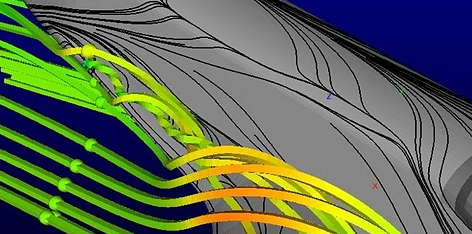Engineering: The Mac is coming back

Most attendees at the Macworld Expo in San Francisco this week — distracted by plentiful iPhone apps, whispered tales of the forthcoming Apple iPad, and the sight of dancing booth workers with their faces covered by unfortunate costumes of gigantic Microsoft Office for Mac icons — may have overlooked a trend: The Macintosh is back in the engineering segment.
Engineering, which was often lumped into the beat called "SciTech," once was strong segment for the Macintosh. Then in the early 1990s, the platform's position was weakened and then lost. But now the Mac appears poised for a strong return.
One piece of evidence was the release by Computational Engineering International (CEI) of a Mac-native version of the company's EnSight CFD, software for analyzing and visualizing computational fluid dynamics. Previously, the Linux software ran on the Mac in the X11 windowing environment.
The company said the new Cocoa version removes a number of issues OpenGL limitations in X11, improved graphics performance and of course, offers Mac users the full range of support for input, Mac UI and services.
Also in the fluid dynamics space is a forthcoming native version of Caedium by Symscape, which was formerly called SymLab. The version was mentioned just the other day in the company's newsletter:
Just to be clear, this is not a Windows version running in Boot Camp or Parallels, and not an X Application, but a true native Mac OS X application. The relative ease of producing a native Mac version of Caedium along with the existing Windows and Linux versions demonstrates the unique cross-platform architecture embedded within Caedium from its initial conception. Caedium will become one of the few (maybe only) commercial CFD analysis tools to run as a native application on the Mac.
In CEI's Ensight blog, called Viz Worth Watching, a post says that Caedium isn't a "replacement for Fluent or Star-CD or STAR-CCM or AcuSolve or any of the myriad of super powerful CFD tools which are available from government labs or industry."
Caedium is a CFD environment from end to end. Its solver inside is OpenFOAM. And it's priced at $1,000 and less, depending on the option. It reads geometry, or lets you create geometry, mesh, apply boundary conditions, solve in OpenFOAM, and visualize the results in Caedium's post-processing. Caedium also exports to EnSight format (and some other 3rd party post-processors) for improved post-processing.
In addition, German developer Graebert this week announced its ARES CAD platform for Mac, Windows and Linux, which supports AutoCAD-compatible command line and scripts.
"Engineering is primed to take off now [on the Mac]," said Darrin McKinnis, vice president for sales and marketing at CEI of Apex, NC. He said there was a "growing ecosystem of applications" to support Mac engineers and while previously, many engineers purchased Mac hardware to then run Linux applications or even Windows programs in virtualization, his company had seen increasing demand for a native Mac version.
McKinnis pointed to a number of engineering teams around the country that are now almost all working on Macs. With the native Mac apps, the loser will be Linux, he said.
McKinnis has a long (and painful) history with engineering solutions on the Mac. He was once an engineer at the NASA Johnson Space Center in Houston, where in 1995, CIO John Garman decided to eliminate "unnecessary diversity" and switch thousands of Mac workstations over to Windows 95.
The battle was joined between NASA's directive at the time for Better, Faster, Cheaper," and what Garman dismissively called "Mac huggers" (a techno-word-play on the "tree huggers" environmentalist sobriquet). It didn't help that Garman was mentioned in a Microsoft advertisement that thanked customers for their "contributions" to Windows 95.
NASA Mac users tried hard to point out that this policy would cause problems. My MacWEEK colleague Henry Norr wrote a series of articles about the fight to keep the Mac at NASA, which won a Computer Press Association award. Here's a slice of his Feb. 12, 1996 front page story:
"Making me take a Pentium is like cutting off my right hand and sewing on a left hand," said a Mac user at NASA's Johnson Space Center in Houston who recently faced forced migration to Windows. "I'll learn to use the left hand, but there's no doubt my productivity is going to suffer, and I'm going to resent it."
To this engineer and hundreds of other Mac users at the space center, such desktop amputations hardly seem like an effective way to comply with agency administrator Dan Goldin's much-publicized motto, "Better, Faster, Cheaper." To them, the space center's new policy of standardizing on Windows is wasteful, unnecessary and infuriating, and they are not taking it lying down.
Eventually, the fight went to hearings at the Inspector General's office. McKinnis was one of the staff who testified there. While the investigation concluded with a report that sided with the Mac users, the Mac was supplanted.
This action was replicated in many other places and segments of course. And Apple's own confused and changing systemware strategy didn't help matters. Cupertino circled the wagons around a dwindling number of segments and the needs of engineers were sometimes neglected. In addition, Apple lost some credibility with claims that some hardware and APIs were 64-bit when they weren't.
"Yes, the time between System 7.5 and Mac OS X were dark days," agreed McKinnis. On the other hand, today's Snow Leopard is solid, he said. "We're running the heck out of it."
